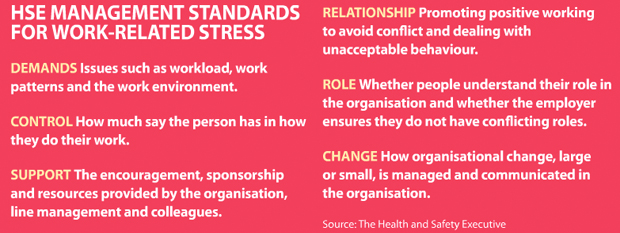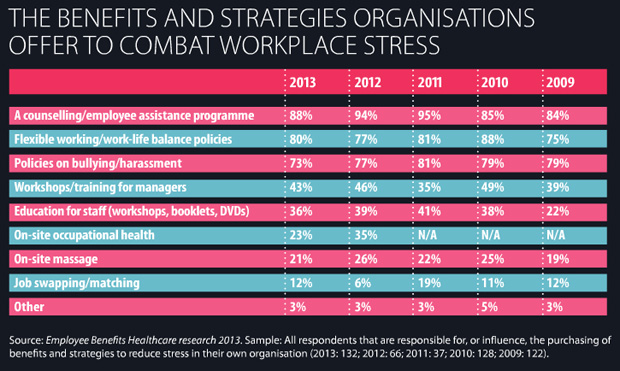Stress and mental health issues are a growing cause of employee sickness absence in the UK.
If you read nothing else, read this…
- Workplace stress is a growing cause of sickness absence.
- Employers can use a number of tools to measure workplace stress.
- Line manager awareness remains key.
The Employee Benefits Healthcare research 2013 , which was published in June, found that 38% of respondents cited personal mental health issues, such as depression and anxiety, as a major cause of sickness absence, while 30% cited work-related mental health issues, such as stress, up from 22% in 2012.
But while many employers collate the level of sickness absence in their organisation, few measure workplace stress.
The Health and Safety Executive (HSE) has set out six management standards for work-related stress, which list the primary sources of stress at work as: demands, control, support, relationships, role and change.
Wolfgang Seidl, head of health management consulting, Europe, Middle East and Africa at Mercer, says: “I think those six principles are very good ones for organisations to endorse. These tend to cause a lot of distress in employees or can be a source of strengthening employee resilience if they are being handled sensitively.”
Business psychology organisation Robertson Cooper also offers a tool, called Asset, to help employers identify the primary sources of workplace pressure and stress.
Its founder and director, Ivan Robertson, says: “One difference with our tool compared with the HSE tool is that we ask employees to what extent they are troubled by those factors. In other words, an employee might have a very low level of control [in their role], but it doesn’t bother them.”
Both tools are a useful starting point for employers seeking the causes of workplace stress, but their efforts should not stop there.
Seidl adds: “The HSE standards should be used simultaneously with other datasets. The more data employers interrogate, the more they get a good picture of what is really going on [in their business].”
Useful datasets
Useful datasets include absence data, claims on insured benefits, such as group income protection or private medical insurance schemes, employee assistance programme (EAP) take-up and findings from health risk assessments.
Seidl adds: “Some organisations, which are really keen on getting to grips with the stress agenda, might go into more sophisticated resilience surveys.”
At a more basic level, employers can add questions about stress and wellbeing to their annual employee engagement surveys.
“Some employers have included presenteeism, wellbeing and stress-related questions,” says Seidl. “They can then see significant correlations between engagement levels and people’s distraction by chronic diseases or conditions, such as stress.”
But Robertson does not think this broad-brush approach works. “It doesn’t really provide enough detail, and it could actually lead to a false picture of where the issues are,” he says. “It’s fine [for employers] to collect the survey data because it gives them a picture across the organisation.
“But usually, if it’s a large issue and they aggregate the results, they end up with a distribution of scores that can look pretty bland because they are putting the data all together.”
Need for anonymity
A major challenge for employers in identifying causes of workplace stress is to maintain employee anonymity because of the sensitive nature of stress and mental health issues.
Employers can use employee focus groups to navigate around this problem and help them create an accurate picture of workplace stress issues.
Andrew Kinder, chairman of the UK Employee Assistance Professionals Association (EAPA) and chief psychologist at Atos Healthcare, says: “A good way around that is [for employers] to focus on those teams or areas or roles where there are known stress issues.
“A good approach that I’ve seen is to run a mini survey completed by, say, 25 staff, and then it’s sent outside to an EAP, and then the EAP would facilitate a session with the team.”
This would involve identifying appropriate support for the problems at play, says Kinder.
“The employees who are experiencing the problems or the issues are also the ones that know, nine times out of 10, what needs to be done to resolve the issues,” he adds.
Robertson recalls one workforce that wanted an exit door at the rear of their office so they could escape from abusive or threatening customers if necessary. “That came up in a focus group,” he says. “It’s not something that a manager looking down on the workplace is going to think of because they don’t have that day-to-day experience.”
Manager intervention
Nevertheless, managers should be able to identify signs of stress in their own teams so they can intervene appropriately and as soon as possible.
The HSE offers a line manager competency indicator tool, which is designed to enable managers to assess whether they have effective behaviours for preventing and reducing stress in the workplace .
Natasha Shearer, founder of Workplace Stress Solutions, says: “Changes in an employee’s behaviour is often the first indication that they may be suffering with stress. For example, detachment, isolation, not contributing to team discussions, coming into work late or working longer hours, irritability, showing anger or aggression are all key indicators.
“Having line managers who can spot these early signs will enable them to have informal discussions with their staff.”
But the fact that stress remains a poorly-defined concept makes management of the problem a challenge for employers.
The UK EAPA’s Kinder says: “There are the HSE stress standards and other tools that talk about pressures on employees. The HSE has its own way of portraying stress, but stress is a perception. Therefore, what some employers and employees might find unacceptable in terms of pressure in the workplace, someone else might be fine with.”
Read also How to manage workplace stress at: http://bit.ly/1713wuX


Viewpoint: Doctor Stavroula Leka and Aditya Jain: Tools to measure workplace stress


The Health and Safety Executive defines work-related stress as the adverse reaction people have to excessive pressures or other types of demand placed on them at work.
Work-related stress is widespread and is not confined to particular sectors, jobs or industries.
It is a significant cause of illness and is known to have a link to high levels of sickness absence, staff turnover and other issues, such as human error that can lead to accidents. Therefore, it is in the best interest of employers to take appropriate measures to assess and manage work-related stress and its contributing factors, which are called psychosocial hazards. This should be part of health and safety risk assessments, which each employer is legally required to carry out.
Work-related stress and psychosocial hazards can be measured in a number of ways and a large number of tools are available to help employers do so. Self-reported questionnaires containing questions about the presence of risk factors in the work environment are widely used because they are inexpensive and easy to analyse.
Other assessments are based on observational approaches, including archival data such as sickness leave, performance measures and accidents, and biological measures.
Examples of questionnaires that measure symptoms of work-related stress include the General Health Questionnaire, the Occupational Stress Indicator and the General Wellbeing Questionnaire. These should be used together with instruments assessing employee exposure to psychosocial hazards, such as temporal aspects of employment and the work itself, demands, aspects of work content, supervision and interpersonal relationships.
Employers should also consider the HSE Management Standards for Work-related Stress indicator tool, the Job Content Questionnaire, the Effort Reward Imbalance Questionnaire and the Copenhagen Psychosocial Questionnaire.
There are also sectoral tools available, such as the EEF Work Organisation Assessment Questionnaire.
Doctor Stavroula Leka is associate professor in occupational health psychology and Aditya Jain is assistant professor in HR management at the University of Nottingham
Read the full digital edition of the Health and Wellbeing supplement.
Hi … being a Wellness therapist (private practice in Bucks) this gave a good overview of stress in the workplace. It’s good to see that companies still take it seriously, despite the economic pressures …but there is more to lose by ignoring it …about to dip into the Health & Wellbeing supplement. (many thanks) Joy
Whilst at work I suffered a period of depression which cost me my job.Unfortunately my company used Capita as it’s “medical care?” provider. If this company had used the methods you suggest in dealing with stress I would still have a job!
ANYONE could have asked about my mental health and been told about it,including conference calls for all to hear! I think it is a bit rich to come from their site to yours….as if they care!
Totally shambolick quack treatment.
??? ?????????? ?????????? ??????????
?????? ?????? – ??? ????????, ?????????????????? ?? ??????????? ? ??????? ????????????? ???????, ?????????????. ??? ????????? ??? ????????????, ??????? ??????? ?? ???????????? ??????? ???????????? ????????????, ??????? ? ?????? ?? ?????????? ??????????? ???????. ??????????? ???????? ??????? ???????????, ??????????? ? ?????? ???????? ?? ??????????.
????????????? ??? ???????????????
? ?????? ????????? ????-?????? ????? ? ?????? ???????? ???????, ????????????? ????? ?? ?????????? ?? ??????? ? ????????????????? ????????????. ??? ?????? ?????????????????? ?????????????, ?????????? ??????? ?????? ?????????? ?? ?????, ?????????? ????????? ??. ???????????? ???????????? ??????? ?????????? ???????. ???? ??????? ??????? ?? ??????? ?????????? ??????? ????????????. ????? ????? ???????, ????????? ???? ???????????? ??????? ????????????? ?????? ????????? ???????????. ??? ??????? ?? ?????????? ?????????, ?????? ??? ? ?????? ??????? ???????????? ????? ?????????? ????, ??????? ? ????? ??????? ??????? ??????? ?? ?????.
?????? ????????? ????????????
?????? ??????????? ?? ????????? ????? ??????????? ? ??????????? ?????????????. ????? ????? ? ???? ??????? ????? ?????????? ????????????? ???????? ?????? ??????.
?????? ???????????? ?????? ??????